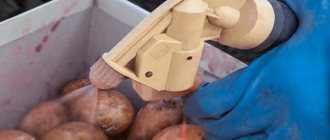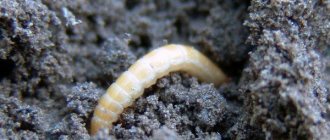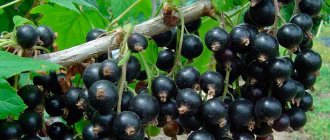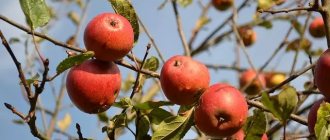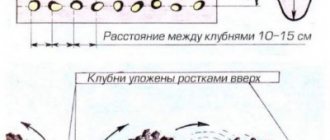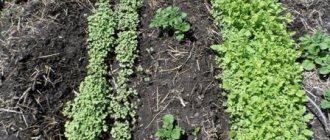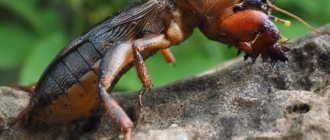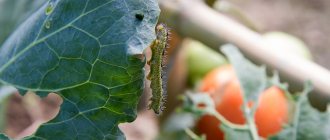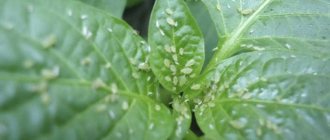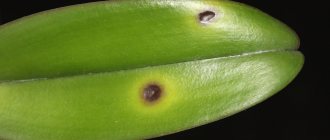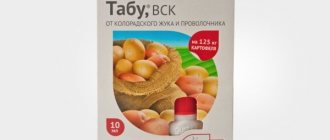The Colorado potato beetle is more capable of harming potatoes than any other insect.
Colorado potato beetle destroying potato bush
The voracious larvae eat up all the leaves within a few days, leaving only the stems.
In order not to be left without a harvest, you will need to treat potato seeds against the Colorado potato beetle: we will tell you in this article how and what is the best way to treat potatoes.
Processing potatoes before planting to increase yield
Despite all the efforts of gardeners to increase potato yields, it is still not possible to avoid crop loss. The cause may be infected planting material, on the surface of which pathogens remain. In addition, larvae of the Colorado potato and May beetles, as well as wireworms, remain in the soil on the site since autumn. All this leads to the fact that the plants get sick, as a result of which the green mass does not increase, they lack nutrition, the tubers grow small with a small amount in the nest.
The larvae of Colorado potato beetles eat the tops, and the plants again lack nutrition. And the wireworm spoils the tubers, as a result they lose their presentation and deteriorate faster during storage. Therefore, when preparing material for planting, one of the important preventive measures is dressing the seed material. These measures will help increase productivity sometimes by up to 30-50%, because the plants grow healthy and are not affected by pests.
Biological development cycle and lifestyle
The beetles overwinter at a depth of 20-40 cm. In the spring they come to the surface, gathering on potato seedlings. A few days after emergence, the mating period begins. After another 3-4 days, females lay eggs, on average 30-40 eggs per clutch.
Help: Larvae are particularly voracious. They develop within two to three weeks, then go into the soil to pupate.
June-July is the time when the first young emerge from the pupae. A small part of young females, laying eggs, give rise to the next summer generation. But the majority of beetles, without reproducing, go into the soil for the winter. They will breed actively next year.
Processing time for potatoes before planting
It is impossible to give specific dates for the start of crop dressing. It all depends on the region where the crop is grown and weather conditions. For germination, potatoes are taken out of pits and cellars 30-45 days before planting in the ground. Pre-sowing treatment is carried out 2-3 days before planting in the ground. But if you carry out the treatment before planting, this will not be a violation.
The main criteria for planting our main vegetable that we should focus on are soil temperature and moisture. The soil temperature should by this time be +7+8º at a depth of 10-12 cm, and the humidity should not exceed 75%.
The most resistant potato varieties
Of course, the risk is quite high, but there are varieties that have special resistance.
- "Sorcerer". It has been actively used since 2000 and has unique taste qualities. It is highly resistant to diseases, due to which, out of a large number of species, it is almost the only one that is immune. The starch content does not exceed 20 percent.
- "Fairy tale". Came into use in 2004. Huge chance of resistance, starch content varies from 14 to 17 percent.
- "Peter's Mystery" He gained fame in 2005 and is quite stable.
What if the most “vulnerable” regions? Undoubtedly, these exist, but it all depends on the time periods when the influence of diseases and pests weakens.
For example, late blight. In 2007, it became almost a global problem in Karelia, Arkhangelsk, Vologda and Kaliningrad. But after two years, the disease failed to affect these cities.
Treating potatoes with Prestige against Colorado potato beetles and wireworms
To protect potatoes from the Colorado potato beetle and wireworm, many gardeners use chemical insecticides such as Prestige or Tabu during pre-sowing treatment. Prestige is a drug from the German company Bayer CropScience, and Tabu is its Russian analogue, more concentrated.
The active ingredient in Prestige and Taboo is the same - imidacloprid. This is a systemic pesticide of contact-intestinal action, which, when entering the body of a larva or adult insect, causes paralysis and then death. The substance does not accumulate in growing vegetables. But Prestige also contains the substance pencycuron. This is a contact fungicide, has a long-term protective effect, which stops the germination of fungal mycelium, protecting against fungal diseases. Moreover, it does not get into the plant itself, but remains only on the tubers and in the soil nearby. Simply put, Prestige protects potatoes from pests and diseases, and Taboo only protects them from pests. This is their only difference.
How to use Prestige
The drug is available for sale in packages of 30, 60, 150, 500 ml. Before use, you must make a working solution. To do this, 60 ml of the drug is diluted in 600 ml of water. This amount of solution is enough to process 60 kg of root vegetables. If the packaging is large, then the exact amount of the product can be measured using a medical syringe. The working solution turns out to be a bright red saturated color.
Having made the working solution, spread the potatoes in one layer on the film and spray them with a spray bottle, turn them over and spray them on the other side. Leave the tubers to dry. Treatment can be carried out 1-2 days before planting in the ground.
You can spray the seed material just before planting, nothing bad will happen. But we must keep in mind that the indicator paint is poorly washed off from buckets or gloves, so after pickling the tubers they are difficult to wash off and perhaps because of this they will become unusable. If this moment does not bother you, then you can spray it immediately before putting it in the soil.
Analogues of Prestige
With a similar mechanism of action and application, its analogues are commercially available:
- Taboo,
- Commander.
- Rector,
- Matador,
- Prestigator.
Before use, carefully read the instructions for use. Since these are potent chemicals, handle them with caution, using personal protective equipment (gloves, goggles, respirators).
Methods of pest control
There are only 2 methods of protecting seed material. In the first case, the tubers are treated with chemicals, and in the second case, using traditional methods.
Treatment with pesticides is more effective, but folk remedies do not affect beneficial insects and cannot harm the health of domestic animals and humans.
For each method of processing seed potatoes, it is necessary to follow the instructions for preparing solutions. High concentrations of pesticides can burn the tubers or will be removed from the plants for a long time, preventing the harvest from being harvested within the usual time frame. Organic matter that is not prepared correctly can also harm the sprouts and delay their development, which would be undesirable.
Treatment of potato tubers against diseases with Fitosporin
Fitosporin is a new generation natural biofungicide used for the prevention and treatment of plants from fungal and bacterial diseases. It has no analogues in terms of concentration of beneficial bacteria and quality. The main active component is the live spore bacterium Bacillus subtilis - Bacillus subtilis. The effectiveness of Fitosporin-M is also enhanced by the Gumi fertility elixir. The product is perfect for pre-sowing treatment of potatoes, while protecting the seed from diseases and accelerating the germination of tubers.
The drug is sold in packages in the form of a paste. To prepare the stock solution, you need to dilute the paste in a 1:2 ratio with water, stir thoroughly to obtain a homogeneous solution. And a working solution is prepared from the mother liquor. For pre-sowing treatment, spray with a solution prepared at the rate of 4 tbsp. l. (60 ml) stock solution per 300 ml (1.5 cups) water. From the resulting amount of solution, you can spray 10 kg of tubers.
The potatoes are scattered on oilcloth and evenly sprayed with the prepared solution, allowed to dry, avoiding direct sunlight. Treatment can be carried out 1-2 days before or immediately before planting.
A brief overview of popular products for pre-planting treatment of potato tubers
In order to permanently get rid of wireworms in a potato plot, all necessary measures should be taken together and consistently. These methods look like this:
- At the very beginning of plowing the area today, the pests will appear on the surface and die or be eaten by birds.
- In the spring, on the eve of planting, add fertilizers containing ammonia or nitrogen to the soil, and then alkalize it.
- When planting potatoes, add a little superphosphate to each hole.
- From the beginning and throughout the entire season, it is necessary to constantly weed the garden and remove weeds along with the roots.
- During the summer, regularly loosen the soil near the potato plantings so that the eggs of the click beetle are on the surface. They die in the sun.
- In the fall, the garden needs to be dug up again to remove pests from the ground.
The wireworm makes its way to the feeding site
As soon as the tubers are in the ground, soil pests move on to them. They feed on juicy sprouts and sweet young roots, and bite into the inside of potatoes. Fortunately, every seed potato has several sprouts. Out of 5-6, 2-3 will remain undamaged, they will germinate and give us a harvest.
Meanwhile, the insects remain in the field and continue to feed on stolons and young nodules. The bush loses strength and does not produce the expected harvest. We would get a lot more if we didn't share with pests. Pre-sowing preparation makes potatoes unattractive, tasteless and even poisonous for wireworms, mole crickets and Colorado potato beetles that have become hungry over the winter.
Chemical means for protecting potatoes before planting
Chemical remedies most often have a prolonged effect for 20-45 days. Active poisons of the drugs disintegrate within a few weeks, which is especially dangerous for early varieties. But if you decide to treat the seed against pests and diseases, then use universal means
- Prestige,
- Taboo,
- Commander,
- Aktara.
When using these products, strictly adhere to the instructions for use.
The following preparations can also be used for dressing potatoes.
Copper sulfate - 1 tbsp. l. dilute in 6 liters of water, dip the tubers into the prepared solution for 2-3 minutes, then allow them to dry.
Potassium permanganate . Prepare a solution at the rate of 10 g of product per 10 liters of water, stir well so that the crystals dissolve. And then the vegetable is immersed in the solution for 30 minutes.
TMTD VSK is a contact fungicide; it does not penetrate the plant, but it suppresses growth and kills mycelial spores on the surface of tubers. Treatment is carried out before planting. The product is mixed in equal quantities with water and the working solution is sprayed at the rate of 200 ml per 10 kg of potatoes.
Prestigator is both a fungicide and a pesticide, an analogue of Prestige. To prepare a working solution, 10 ml of the product is diluted in 10 liters of water. The working solution is sprayed on the planting material 2-3 hours before planting. Consumption rate – 100 ml per 10 kg of tubers.
Appearance
First, let's look at what the beetle and the potatoes damaged by it look like.
Adult and larvae
The adult Colorado potato beetle has quite decent sizes - from 8 to 12 mm in length, about 7 mm in width. The shiny chitinous shell is very durable, colored with longitudinal stripes of yellow-brown color. Well-developed wings allow them to fly long distances. The legs have hook-claws that help them move around plants.
The insect lays small, glossy, bright orange eggs. The body of the larva is “hunched”, thickened at the back, 15 mm in length. The color changes from brownish-brown to orange-red, with black dots on the sides.
Affected potatoes
A bush favored by pests can be identified by the following characteristics:
- bright orange spots appear on the underside of the foliage - these are egg laying;
- The bush was covered with larvae on the upper surface of the foliage;
- at the top there is noticeable damage to the leaf blades, which over time have been eaten away to the central veins;
- If measures are not taken, the tops will remain short, rough, yellowed shoots.
How to treat potato tubers with potassium permanganate
When treating potatoes with Prestige or Tabu, we use strong chemicals - insecticides. They kill not only the larvae of the Colorado potato beetle and wireworm. But it’s worth thinking about how big it will grow later if it’s treated with such strong agents? The proposed remedy will do much less harm, but at the same time will protect the seed from further development of diseases and damage by insects.
To prepare it for 10 liters of water, take:
- 1 tsp. margartsovka,
- 2 tsp. boric acid,
- 3 tsp. (or 1 tbsp.) copper sulfate.
Add them to the water and stir well. Potassium permanganate will protect potatoes from wireworms, copper sulfate will protect them from fungal diseases, and boric acid is a growth regulator and will make the vegetable germinate faster.
For greater effect, you can add 1 liter of mullein to the solution. It contains many microelements, enzymes and humates, which will also be beneficial for the vegetable.
Then place the box with potatoes on a wide basin or bathtub, and water the tubers from a watering can so that they are all moistened with the prepared solution. The solution will wet the entire surface of the tubers and flow into the basin through the holes in the box.
The solution can be poured back into the watering can and poured over another box of potatoes.
There is no need to soak the potatoes in the solution, since they already have sprouts on them that can burn during processing. Place the box with the processed vegetables in the sun or under a canopy so that the vegetables dry.
Work can be carried out no earlier than 5 days before disembarkation. By the time of planting, the potatoes should turn a little green so that nutrients are more attracted to the sprouts.
Growth stimulants
The use of these substances allows you to obtain maximum yield. This is achieved through:
- rapid development of the root system;
- early shoots;
- awakening “sleeping” eyes;
- protection against infections and high resistance to adverse weather conditions.
In addition, potatoes become more nutritious because their starch and vitamin content increases.
This is one of the most famous drugs. The active ingredients are a complex of 2,6-dimethylpyridine-1-oxide with succinic acid.
When using it:
- shoots appear 5–6 days ahead of schedule;
- stems develop thicker;
- the plant more easily tolerates damage caused by the Colorado potato beetle;
- the crop becomes resistant to late blight.
The manufacturer promises a harvest 24% higher than usual
You can read more about how to grow a good potato crop in our article.
The active substances of the product are modified humic acids, for which the acidity of the soil does not matter. The formula also contains polyhydric alcohols, carboxylic acids obtained from natural products.
Stimulation of growth is achieved by increasing the biological activity of intracellular water, accelerating cell division and regulating the intensity of mineral nutrition. The drug works in the following areas:
- increases oxygen access;
- increases the synthesis of the main energy substance ATP;
- accelerates the absorption of nutrients from the soil;
- improves carbohydrate metabolism, promotes the formation of sugars;
- increases resistance to frost and heat;
- helps increase the volume of the root system by 60%, leaf mass - by 35%.
The drug also strengthens the plant’s immunity and reduces susceptibility to diseases by 1.5 - 2 times. The consumption of fungicides is reduced by 2 times by reducing the frequency of treatment of the area.
"Vympel 2" increases the volume of root exudates, increases the activity of microorganisms inhabiting the soil, promotes the growth of their numbers and thereby stimulates the accumulation of humus. This creates conditions for optimal mineral nutrition of the crop and reduces the use of mineral fertilizers by up to 70%.
Treatment of potatoes against late blight before planting
Some gardeners ask and ask whether it is possible to treat late blight before planting? Late blight on potatoes is a threat to most of the crop. Warmth and moisture are the optimal environment for the development of fungal infections. Spores of the causative agent of late blight live in the soil and remain on the tubers. They can be carried by water flows or wind, and remain on last year's plant debris. Fighting the disease is difficult, but necessary.
Dry weather and hot sun rays prevent the development of late blight. But it is difficult to predict in advance what the weather will be like in summer. For the purpose of prevention, it is advisable to treat tubers at the pre-sowing stage. This will help prevent the proliferation of spores at first. Fitosporin will cope well with this task.
To prevent massive crop loss, gardeners need to use potato varieties that are resistant to late blight. In addition, for preventive purposes, it is necessary to treat the soil in advance. Pre-sowing treatment is carried out using chemicals - fungicides, biological and folk remedies.
Resistant varieties
Potatoes resistant to the Colorado potato beetle during the growth period are capable of producing special substances - glycoalkaloids, which inhibit the development of insects. They inhibit the digestive system of the pest, the larvae grow slowly, and the pupation process takes a very long time. But at the same time, the taste qualities of such a product are not always at their best, and at the moment there are no absolutely stable varieties.
Next, we list the most common potato varieties that are characterized by relative resistance to the Colorado potato beetle:
- “Zarevo” is a mid-late potato variety; it has white flesh, which is covered with a pink mesh skin. From one hectare it is possible to collect 500-550 centners;
- “Lasunak” - the peel is white, the flesh is white with a yellow tint. Late ripening variety. Resistance to rhizoctonia is high, and resistance to viral and late blight infections is relatively high. Starch content - about 18-22%;
- “Svitanok” is a mid-early potato with pink skin and cream-colored flesh. Resistance to the Colorado potato beetle is relative, but the regenerative ability of the variety after damage is increased;
- “Peresvet” - has good resistance to soil pests, as it has a high content of alkaloids;
- “Nakra” is not only a variety resistant to the Colorado potato beetle, but unlike many, it is considered quite tasty.
In addition, many gardeners note varieties such as:
- "Dining room 19";
- "Nikulinsky";
- "Lugovskoy";
- "Orbit";
- "Pace";
- "Dolphin";
- "Morning".
However, there is still quite a lot of controversy surrounding such varieties regarding their benefits, and scientists themselves have an ambiguous attitude towards transgenic potatoes. Agronomists insist that if the Colorado potato beetle refuses to eat such tubers, then humans should not eat them.
It is safer to pay attention to the pre-sowing treatment of potatoes. Many gardeners make the mistake of planting untreated tubers, and then spend a lot of time fighting the Colorado potato beetle.
Take care of your health, save time and have a good harvest!
Biological agents for processing potatoes
Biological remedies are considered natural antibiotics. They inhibit and suppress harmful microflora and fungi, and strengthen plant immunity. I have already talked about Fitosporin, and now briefly about other biological products used for treatment before planting.
Drug Maxim . This is a natural fungicide-antibiotic that inhibits and kills harmful bacteria. It is designed to protect plants from diseases that are transmitted with soil and seeds. After application to bulbs, tubers, roots and stems, particles of the product form a protective film around them. Pathogenic organisms cannot penetrate this barrier, so plants are not affected by diseases. A protective barrier also forms near the rhizome of the plant.
The drug is diluted at the rate of 4 ml per 100 ml (or 40 ml per 10 l) of water. This amount is enough to spray 10 kg of tubers. The effect of the drug lasts for 12 weeks. The working solution is sprayed onto the potatoes or immersed in a net in the solution for 1 hour, then allowed to dry.
Immunocytophyte is a biostimulant that strengthens the resistance of vegetables to 150 ml of water. The resulting working solution is sprayed onto the tubers 2-3 days before planting in the ground.
Agate -25K also refers to biofungicides. The working solution is prepared at the rate of 1 g of product per 4 liters of water. The treatment is also carried out 2-3 days before planting the tubers in the ground.
How to process correctly
Before the procedure, you must carefully read the instructions for the specific drug and strictly follow all recommendations. But there are also general rules for pre-planting processing of potatoes.
Deadlines
Most products are applied to tubers (preferably clean, washed) shortly before or immediately before planting. The exception is some biological fungicides, for which activation of dormant microorganisms is important. If there are no other instructions in the instructions, then treatment with a biological product is carried out a week before planting the potatoes. It is also possible to irrigate before planting tubers for germination, with further repetitions every week until planting.
Application methods
Liquid products are applied to potatoes using special spraying devices: hand sprayers (for small volumes of seeds), pump or hydraulic sprayers. Fungicides with imidacloprid (Prestige) penetrate the tubers even with partial application, so it is not necessary to turn the seed over to treat the opposite side if this is labor intensive. With other preparations, it is advisable to evenly moisten the potatoes on all sides. After processing, the tubers are dried, protecting them from direct exposure to sunlight, and then planting begins.
Large farms use special devices (dressers), which are attached to planting equipment and wash the tubers immediately before planting them in the ground.
Amateur vegetable growers sometimes do without sprayers. They practice simply immersing the tubers (placed in nets) in liquid.
Dusting with ash (or other powdery substances) is carried out on tubers moistened with water or a solution of humates. You can spread the seed outdoors in rainy weather, and then dust it after the rain.
How to treat potatoes before planting against wireworms and Colorado potato beetles
In addition to chemical and biological preparations, you can treat potatoes using folk remedies.
Garlic infusion . It is prepared at the rate of 1 kg of garlic pulp per 10 liters of water. Infuse for 2-3 hours, and the strained infusion is poured or sprayed on all sides of the planting material. Or, the root vegetables are dipped into the solution for 2 hours, and then the tubers are dried.
Whey + ammonia . To do this, add 1 liter of whey to 9 liters of water and add 40 ml of a 10% aqueous ammonia solution to the same.
Infusion of birch ash . Fine ash is poured with warm water and left for a day. Then the tubers, placed in a net, are dipped in the infusion for 5 minutes, then dried. For the best effect, they are dusted in wood ash with the addition of tobacco dust.
Treatment during the growing season
The growing season is the most difficult period in the “life” of potatoes, because they are “under the gun” of all kinds of pests and diseases. When the first greenery appears, the Colorado potato beetle becomes active. During the entire period of development, the insatiable mole cricket gnaws on potatoes - both the roots of the bush and the tubers. The wireworm also loves to feast on emerging tubers. Making his long passages in them, he can ruin the entire harvest.
- 5 soil pests that are depriving you of your potato and root crop harvest
There are many plant pests in the soil, but these five can be considered the most dangerous for the harvest of root crops and potatoes.
During active potato growth, diseases also often make themselves felt. During the period of budding and the beginning of flowering, under favorable weather conditions (high humidity), signs of late blight often appear. Conversely, the lack of moisture and persistent high temperatures can cause Fusarium wilt disease in potatoes. This disease often causes tubers to become damaged by dry rot during storage.
- Potato diseases: determined by harvest
Have you harvested the “second bread”, but the tubers are covered with strange spots, growths and sores? We will help you determine what happened to the potatoes and how to prevent diseases in the future.
How to treat potatoes during the growing season against pests
The fight against the Colorado potato beetle during the period of potato growth should begin immediately after the appearance of the first individuals. It is necessary to spray the bushes in dry, windless weather, not forgetting the underside of the leaves, where the clutches and larvae are located.
Biological agents effectively fight the Colorado potato beetle. They do not accumulate in plants and fruits, which makes them practically harmless to people: these are Fitoverm (0.4 ml diluted in 10 liters of water, treated with an interval of 20 days 3 times), BioKill (4-8 ml per 10 liters of water, once at 20 days) and Bitoxibacillin. The bushes should be sprayed with Bitoxibacillin solution (40-100 g diluted in 10 liters of water) three times with the following interval: at temperatures above 20°C - 6-7 days, at lower temperatures - 8-10 days.
Chemical preparations will also help in the fight against the American beetle: Kinmiks (1.5-2 ml per 10 l of water), Confidor Extra (0.3-0.5 g per 10 l of water), Coragen (0.5 ml per 10 l water), Aktara (0.6 g per 10 liters of water), Commander (1 ml per 5 liters of water) and others.
Opponents of “chemistry” can try to cope with the pest using traditional methods. The most effective (and most labor-intensive) of them is manual collection of beetles and their larvae. You can place traps with potato peelings along the rows, and then collect and destroy the insects that come to feast on the potatoes.
Infusions of the following substances have proven themselves to be quite good:
- wood ash with soap (pour 3 kg with 10 liters of boiling water and 40 g of liquid soap - leave for 12 hours);
- walnut (take 300 g of shell and leaves and add a bucket of boiled water; after a week the solution is ready for use);
- birch tar (dissolve 150 g of tar in a bucket of hot water).
- Colorado potato beetle - not easy to get rid of, but possible
Operation Colorado Beetle: find and neutralize!
During the growing season, the click beetle begins its dirty work. The nutcracker gained national fame due to its voracious larva, nicknamed the “wireworm” for its appearance. Gardeners can fully appreciate the damage caused by wireworms only after harvesting. The numerous moves it makes in the tubers make the grown potatoes practically unfit for consumption.
To combat wireworms, drugs such as Aktara are used (0.6 g per 10 liters of water - water the potato plantings with the resulting solution).
Among the popular methods are the following:
- Place bait in the ground - potatoes, beets or carrots (be sure to mark their location). Don’t forget to take them out along with the larvae every 3-4 days and replace them with new ones;
- place a predator on your property that will happily eat wireworms - a ground beetle - and it will help you reduce the number of the pest.
- 10 ways to deal with wireworms
Find out what wireworm looks like and how to effectively fight it.
Another underground “rodent” that threatens to leave you without a harvest is the mole cricket. It moves along the surface layer of soil and spoils everything that gets in its way: roots, plants, and potato tubers.
Scientists suggest using Thunder (spread 30 g of granules over 10 sq.m. and embed into the soil to a depth of 3-5 cm), Terradox (20 g per 10 sq.m.) or ready-made Medvetox bait (2-3 g per 10 sq.m.) to combat mole crickets. 1 sq.m – embedded in the soil to a depth of 3-5 cm).
People fight the mole cricket in their own way:
- Prepare an infusion of onion peels (infuse 800 g of onion peels in 10 liters of hot water for 4 days). Pour the prepared liquid into the passages made by the bear. Instead of infusion, you can use soapy water or regular boiling water.
- Pour calcium carbide into the wells. When it rains, the substance will react with water and the release of gas, acetylene, which is dangerous for the mole cricket, will begin. If the weather is dry, add water yourself to the passages made by the insects.
- Place the pine needles between the rows or dig them in lightly. The pine smell, according to many summer residents, will force the mole cricket to leave your area.
- How to deal with mole crickets - effective drugs and folk remedies
Don’t know how to get rid of mole crickets on your property? Our recipes will help you protect your garden crops from this underground pest.
The potato moth (fluorimea), or more precisely, its caterpillar, also causes a lot of problems for potato plantings. She gnaws leaves, stems, and potato tubers. In tubers, its passages are usually located near the surface, but the caterpillar can also penetrate inside the fruit, causing it to rot.
To combat potato moth, dissolve 1 Inta-Ts-M tablet in 10 liters of water and spray the potato bushes with the resulting solution, not forgetting the lower part of the leaf blade. You can also use a preparation such as Iskra (1 tablet per 10 liters of water), but manufacturers recommend treating with Iskra twice.
We recommend the following folk remedies:
- Take 1 cup each of finely chopped wormwood and wood ash, mix them and pour 3 liters of boiling water. After 3-4 hours, the remedy for combating potato moth is ready.
- Dissolve yeast and baking soda (300 g of each substance) in 10 liters of water. Strain the solution before use.
- A solution of ash and soap, which is used to combat the Colorado potato beetle, is also suitable.
How to treat potatoes during the growth period against diseases
During the growing season, potatoes suffer not only from attacks by insect pests, but also from various diseases. The main one is late blight. If you did not treat the tubers against late blight before planting, or the soil in the area is heavily contaminated, then traces of the disease may appear on the bushes. This means that it is necessary to start processing the plant now, during the growth period. Start the fight at the first sign of illness. Preparations such as Bordeaux mixture (dissolve 100 g of copper sulfate and calcium hydroxide in 10 liters of water) and Abiga-Peak (50 g per 10 liters of water) will help against late blight. If cases of infection are isolated, then use Albit (1 ml per 10 liters of water).
All these drugs will also help in the fight against Alternaria (potato brown spot). This disease causes leaves and stems to die, which can lead to a 30% reduction in tuber yield.
Some manufacturers recommend not waiting for late blight to appear, but carrying out preventive spraying during the closing phase of the rows (Shirma - 3-4 ml per 4 liters of water) and continuing treatment with an interval of 7-10 days 3 more times.
Treatment can also be carried out with the microbiological preparation Fitosporin-M, which is safe for people and animals (20-25 g per 10 liters of water). It will not only protect potato plantings from late blight and Alternaria, but also strengthen their immunity, and also accelerate plant growth.
Folk remedies are also used to combat potato late blight:
- Add 1 liter of skim milk and 15 drops of iodine to a bucket of water. Spray the bushes with the resulting solution. It is recommended to repeat the procedure at intervals of 2 weeks.
- For prevention, use fermented milk products. For example, mix 10 liters of water with 1 liter of kefir and leave for 2-3 days in a warm place for the mixture to ferment. Use for spraying once a week.
- 9 folk ways to combat late blight from readers of the magazine “Matchmakers at the Dacha”
We protect tomatoes from late blight without “chemicals”.
